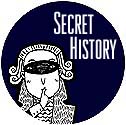
Comment
on this story |
 |

The homecoming of a Market Square icon
by Jack Neely
The large, shiny, semi-conical metallic object appeared suddenly on the square’s south end early last week, as if it had landed there from outer space. A colleague assumed it was a frou-frou adornment for a square that some have complained is, in its latest incarnation, too plain.
Polished, and sitting on a brick-and-concrete pedestal, it looks new. I didn’t recognize it at first, myself. In my memory, it was always a dull brown. Now it’s bright, like platinum. It’s chipped around the lip. Of appropriate size, and marred almost artfully by a crack, it looks distinguished and famous. Generations of kindergartners will believe it to be the Liberty Bell.
As far as I can tell, we’re allowed to touch it. Rapping it with your knuckles is not an especially comfortable thing to do, but it does allow you to hear a muffled bong.
There was a time when it was the oldest thing in the oldest part of what only older folks remember as the old Market House. The long, incoherently Victorian farmer’s market has been gone since the 1960. When that building was built in the middle of the square in 1897, it incorporated City Hall, an existing building at the north end. (Market Square’s City Hall was where the offices of city government were located before it moved to so-called “Old City Hall.”) That Market Square City Hall, which included the police station and the calaboose, went up in 1888.
The bell’s manufacturer, McShane Bell Foundry, of Baltimore, is embossed on the bell, as is its date: 1883. That’s a minor mystery. Did the bell spend that half-decade sitting on a loading dock in Baltimore, waiting for a home?
The police chief operated the bell with a button in his office below. When he pressed the button, it set off a tension-loaded 1,200-lb. weight which rang the bell. The resounding bong could be heard in every corner of Knoxville’s corporate limits.
The bell’s original purpose was to sound alarms, especially for fires and police emergencies. There were plenty of both, especially in this neighborhood. This bell would have sounded the alarm for the Million-Dollar Fire of 1897; half a block away, on Gay Street, it’s still Knoxville’s most ruinous fire. It might also have tolled the first news of the Flat Creek Horror, the 1889 train wreck that killed several city officials. It likely sounded the alarm of the bizarre streetcar riot of 1897, the escape of Kid Curry in 1903, the Woodruff’s explosion of 1904, maybe the New Market Train Wreck of 1904.
The bell hung there for nearly 50 years, but it apparently wasn’t used much after 1920. City Hall lost its original purpose, and the building got rickety fast. The 2,600-lb. bell, was beginning to strain the building’s beams and joists. Ringing it was dangerous.
A newspaper article of 1932 refers to this bell as if it’s an ancient curiosity: “tho unused for years, its tones are still mellow and vibrant.” At the time, it hung over the dusty old City Council chambers, which had been vacant more than a decade.
There was some concern that the bell would fall from its belfry. The thing might have left a meteor-hole through three floors of the building. Sometime in the middle 1930s, the city extricated the bell, and it began a 45-year odyssey around the community. First it was mounted at the Burlington fire station in East Knoxville. By then its old clapper was missing, and firemen rang it with a sledgehammer. They used it to signal blackout drills during World War II.
Then, in 1945, it moved out to the Bean Station area, in Grainger County. The city donated it to Kingswood School. It might have seemed an appropriate retirement spot for a hardworking remnant of the Victorian age. Kingswood was adjacent to defunct old Tate Springs, which had been a popular weekend resort for 19th-century Knoxvillians. As some students later remembered, they rang the bell to celebrate V-E Day that April. Mostly it served as a campus curiosity, a backdrop to class pictures.
In 1978, some city councilmen remembered the old bell and called for its retrieval to Market Square. The following year they gave it a little pedestal on the square’s north end. It sat there until 1986, when the city erected the postmodern market shed. They made a belfry for it, and hoisted it into place. A belfry is a good place for a bell, but it seemed lonesome up there, silent, untouchable. If you can’t ring an antique bell, you’d like to at least get a good look at it.
By the second turn of a century this bell has witnessed, folks were tired of the shed, and the fact that it blocked views. They pulled down the shed but saved the bell.
And here it is, looking better than I’ve ever seen it. As it happens, McShane Bell Foundry of Baltimore is still in business, now mostly in the church-bell trade. Our bell got shipped back to its birthplace. McShane cleaned the bell and polished it and gave it a protective coating. They recommended, thanks to that crack, that it not be rung much. Next time I see something alarming, though, I’ll be tempted.

March 4, 2004 • Vol. 14, No. 10
© 2004 Metro Pulse
|





